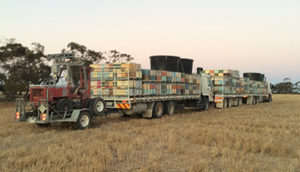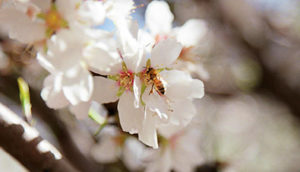Read the latest information on
Foot-and-mouth disease

Trucks carrying millions of bees – and water supplies and forklifts – move at night after all the foragers have returned to the hive, so you might not actually see them being moved. Image: courtesy of Ian Zadow
The annual spring movement of hives has commenced, as beekeepers move hives from one area of the country to another following the flower blossoms of nut, fruit and vegetable plants that need pollination by bees to produce a crop.
The season starts with almonds, usually in August, which are almost entirely dependent on bees for pollination and seed set.
Plant Health Australia’s National Manager for Surveillance, Dr Sharyn Taylor, says that many commercial beekeepers move their hives for pollination contracts and to follow honey flows as the season progresses.
“Around 200,000 bee hives are placed in orchards in north west Victoria for almond pollination alone, which takes only a month to complete,” said Sharyn.
“Hiring hives is the most common way growers get the hives their crops need for pollination. Long distances are travelled by some beekeepers in the migration, often between states.”
This movement of hives, as well as the drifting and robbing habits of honey bees, means that any pests or diseases can be difficult to contain.
“Events like this can be a cause for biosecurity concern,” advised Sharyn.
“Every beekeeper should be using industry best practice guidelines to provide a high standard of pollination service by making sure hives are strong and disease free,” said Sharyn.
“When hiring hives for pollination, many beekeepers and growers find it a good idea to have a pollination agreement. This approach has the advantage that the growers can specify exactly what they need and what they expect to get.”
Although they can vary, key aspects of a pollination agreement should specify:

Almond pollination and yield is highly dependent on honey bees, which can be brought into the orchard in large numbers over the flowering period. Image: courtesy of Almond Board of Australia
“Agreements, or contracts, are useful because there’s no confusion over what the grower thinks they are hiring and what the beekeeper thinks they need to supply,” said Sharyn.
They become very important if there are any problems with what’s supplied or something happens to the bees when they are working the crop. To get an idea of whether you’re getting what you pay for, growers should have a look to see if bees are moving in and out of hives.
Beekeepers providing pollination services should be particularly vigilant for pests and diseases as they prepare hives for movement, and also when hives return back home, to make sure no diseases have been picked up.
If you see anything unusual on bees, call the hotline on 1800 084 881 and you’ll be put in touch with your local department of primary industries.
BeeAware website is a source of information for beekeepers and growers. The site includes the Australian Honey Bee Biosecurity Code of Practice, contact details for bee biosecurity officers, videos and links to online biosecurity training.
There’s a sample pollination contract in the Australian Beekeeping Guide on page 121 in section 18 on ‘Honey bee pollination’.